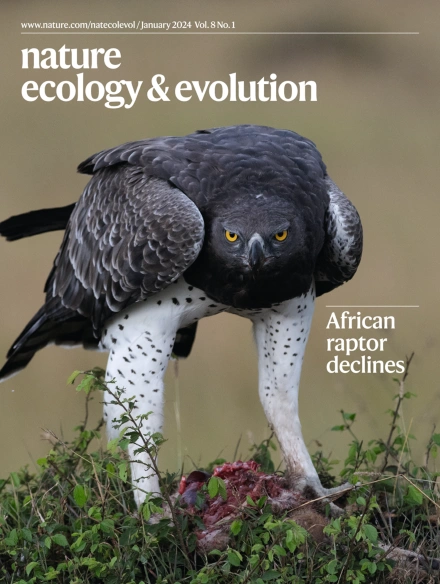在第一次恐龙辐射中出人意料地衍生出特征的卡尼亚兽脚亚目恐龙。
IF 13.9
1区 生物学
Q1 ECOLOGY
引用次数: 0
摘要
早期恐龙的多样化在陆地生态系统中产生了重大的生态变化,在三叠纪/侏罗纪边界(~ 2.01亿年前(Ma))以大量恐龙为主的四足动物组合达到顶峰。因此,研究恐龙的初始多样化对认识中生代组合的建立至关重要。然而,在少数保存已知最古老恐龙(~233-227 Ma,卡尼期)的地质单元中,缺乏地层连续的化石资料,使我们对这种初始多样化的理解变得模糊。阿根廷西北部的Ischigualasto组(231.4-225.9 Ma)拥有丰富的脊椎动物组合,新的研究发现了丰富且地层上接近连续的化石记录,为恐龙早期多样化提供了新的见解。在这些发现中,我们报告了Anteavis crurilongus gen. et sp. nov.,这是一种早期分化的兽脚亚目恐龙,它支持了卡尼晚期中小型恐龙的显著多样性。安特拉维斯是在新蜥脚类动物之外发现的,但它具有以前被认为是新蜥脚类动物独有的特征。研究表明,Ischigualasto组恐龙的多样性和丰度比之前认识到的要高,特别是在小型食草动物(<30 kg)和中型食肉动物(30-200 kg)中。这种多样化发生在伊奇瓜拉斯托,当时气候向半干旱条件转变,但更湿润的条件的回归导致恐龙记录的空白开始于228.91±0.14 Ma。仅仅1500万年之后,在诺里亚中期,恐龙记录在盆地中恢复了其丰富性和多样性,但现在它的特征是体型更大的物种。我们的发现表明,至少在泛大陆西南部,早期恐龙的多样化可能会被气候驱动的动物更替打断。本文章由计算机程序翻译,如有差异,请以英文原文为准。
A Carnian theropod with unexpectedly derived features during the first dinosaur radiation.
The early diversification of dinosaurs produced a major ecological change in the terrestrial ecosystems, culminating with tetrapod assemblages dominated in abundance by dinosaurs by the Triassic/Jurassic boundary (~201 million years ago (Ma)). Therefore, studying the initial diversification of dinosaurs is crucial to understand the establishment of Mesozoic assemblages. However, the lack of stratigraphically continuous fossil data in the few geological units that preserve the oldest known dinosaurs (~233-227 Ma, Carnian age) obscures our understanding of this initial diversification. The Ischigualasto Formation in northwestern Argentina (231.4-225.9 Ma) yields a rich vertebrate assemblage and new studies resulted in an abundant and stratigraphically near-continuous fossil record, which offers new insights into the early diversification of dinosaurs. Among the discoveries, we report Anteavis crurilongus gen. et sp. nov., an early-diverging theropod, which supports the notable diversity of small- to medium-sized dinosaurs during the late Carnian. Anteavis is recovered outside Neotheropoda, but it has features previously thought to be exclusive to that group. We show that dinosaur diversity and abundance in the Ischigualasto Formation were higher than previously recognized, particularly among small herbivores (<30 kg) and medium-sized (30-200 kg) predators. This diversification occurred in Ischigualasto during a climatic shift to semi-arid conditions, but the return of more humid conditions resulted in a gap in the dinosaur record that started at 228.91 ± 0.14 Ma. Only 15 million years (Myr) later, in the middle Norian age, the dinosaur record recovered its abundance and diversity in the basin, but now it was characterized by larger-bodied species. Our findings demonstrate an early dinosaur diversification probably punctuated by a climate-driven faunal turnover in, at least, southwestern Pangaea.
求助全文
通过发布文献求助,成功后即可免费获取论文全文。
去求助
来源期刊

Nature ecology & evolution
Agricultural and Biological Sciences-Ecology, Evolution, Behavior and Systematics
CiteScore
22.20
自引率
2.40%
发文量
282
期刊介绍:
Nature Ecology & Evolution is interested in the full spectrum of ecological and evolutionary biology, encompassing approaches at the molecular, organismal, population, community and ecosystem levels, as well as relevant parts of the social sciences. Nature Ecology & Evolution provides a place where all researchers and policymakers interested in all aspects of life's diversity can come together to learn about the most accomplished and significant advances in the field and to discuss topical issues. An online-only monthly journal, our broad scope ensures that the research published reaches the widest possible audience of scientists.
 求助内容:
求助内容: 应助结果提醒方式:
应助结果提醒方式:


